- Javonte Williams lost playing time in 2024: Williams was the clear starter to begin 2024, but he became part of a three-man committee by the end of the season.
- A new start with the Dallas Cowboys: Williams is competing with two other running backs for the starting job, but he could be a fantasy starter if he wins the job.
- Subscribe to PFF+: Get access to player grades, PFF Premium Stats, fantasy football rankings, all of the PFF fantasy draft research tools and more!

PFF’s Fantasy Football Player Profile series delivers the most in-depth fantasy football analysis available for the 2025 season.
Using PFF’s exclusive data, we evaluate player performance, competition for touches and how teammates and coaching staffs will impact each player's fantasy football outlook.
Last updated: 7:15 a.m. Wednesday, June 4
Player Performance
Javonte Williams entered the league as a second-round pick in the 2021 NFL Draft, immediately impressing as Melvin Gordon III’s backup by becoming a tackle-breaking machine and finishing with more fantasy points than Gordon, thanks in part to a Week 13 breakout performance where Williams was the overall RB1 with Gordon sidelined.
He took over as Denver’s starter in 2022 but saw limited usage early before finally becoming the lead back in Week 4. Unfortunately, he tore his ACL and LCL on the first play of the second half of that game, ending his season. Williams returned in 2023 but wasn’t the same player, with his missed-tackle rate decreasing by half.
Hopes were high for a bounce-back in 2024, but Williams’ per-play rushing metrics remained stagnant, and his involvement in the passing game dipped with Bo Nix under center. Still, over the past three seasons, Williams was targeted on 27.2% of his routes and caught a pass on 22% of them — both of which rank second among all running backs during that span.
Williams played between 51% and 68% of snaps in each game from Weeks 1 to 9 last season, averaging 11 carries and 43 rushing yards per game, only slightly down from previous years. However, Denver moved to a full-blown committee in the second half of the year. Williams failed to log double-digit carries in any game and posted 1 rushing yard or less in four of his final eight appearances.

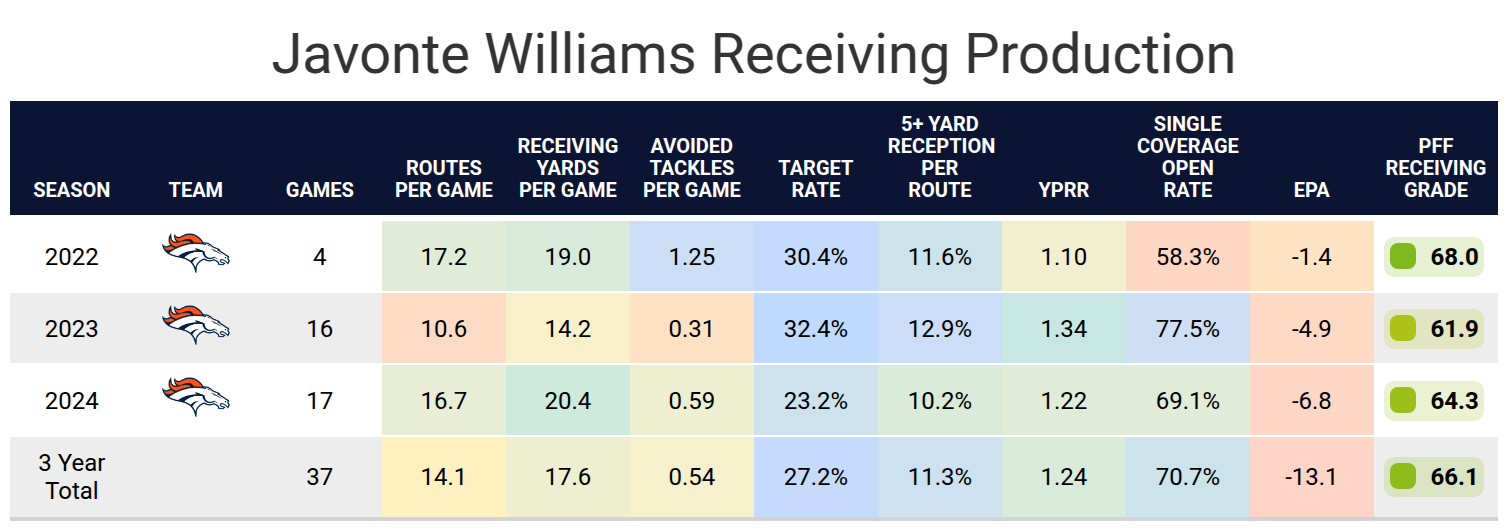
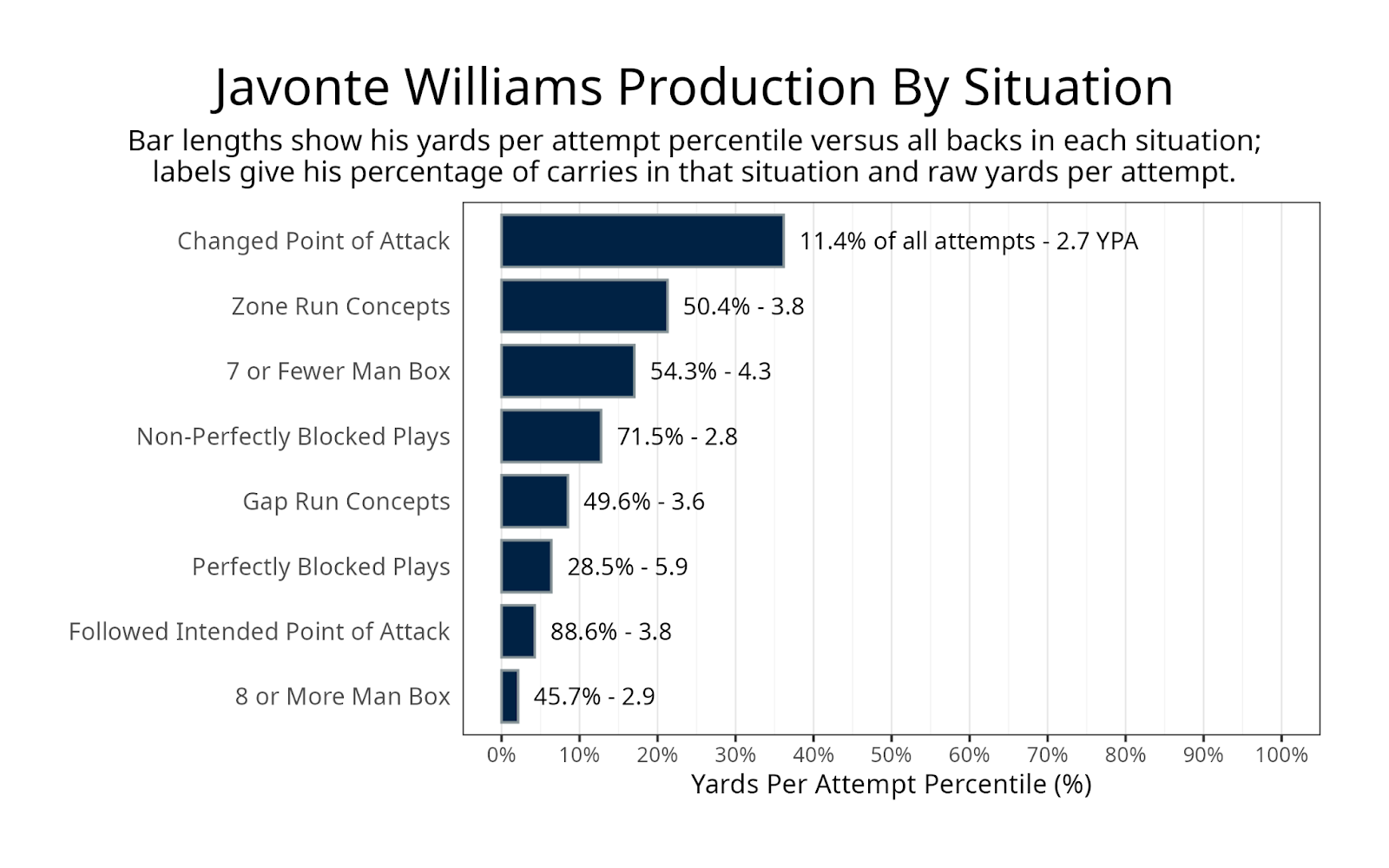
Projected Role
Williams has a fresh start with the Dallas Cowboys, signing a one-year, $3 million deal. The Cowboys moved on from Rico Dowdle, Ezekiel Elliott and Dalvin Cook, instead bringing in former Panthers back Miles Sanders via free agency and selecting Jaydon Blue in the fifth round of the draft.
This backfield is wide open heading into training camp, with the player who performs best likely earning the bulk of the touches. However, the depth chart could remain fluid throughout the season, shifting based on performance and availability.
Sanders found success as a two-down runner in Philadelphia before shifting to more of a third-down role in Carolina. Blue, meanwhile, enters the league with limited experience after primarily serving as a backup in college. Williams stands out as the most proven early-down runner in the group and the most productive receiver out of the backfield. While Williams and Sanders possess prototypical size for the position, Blue is notably smaller, though recent success stories like Kyren Williams, De'Von Achane and Jahmyr Gibbs prove that size isn’t necessarily a limitation.
It’s possible this backfield settles into a more traditional split, with one primary runner and one primary receiving back, and any of these three could claim either role. The ideal outcome for fantasy managers would be Williams regaining a featured workload like he held during the first half of 2024. But given the competition, there’s also a realistic chance he falls to third on the depth chart.
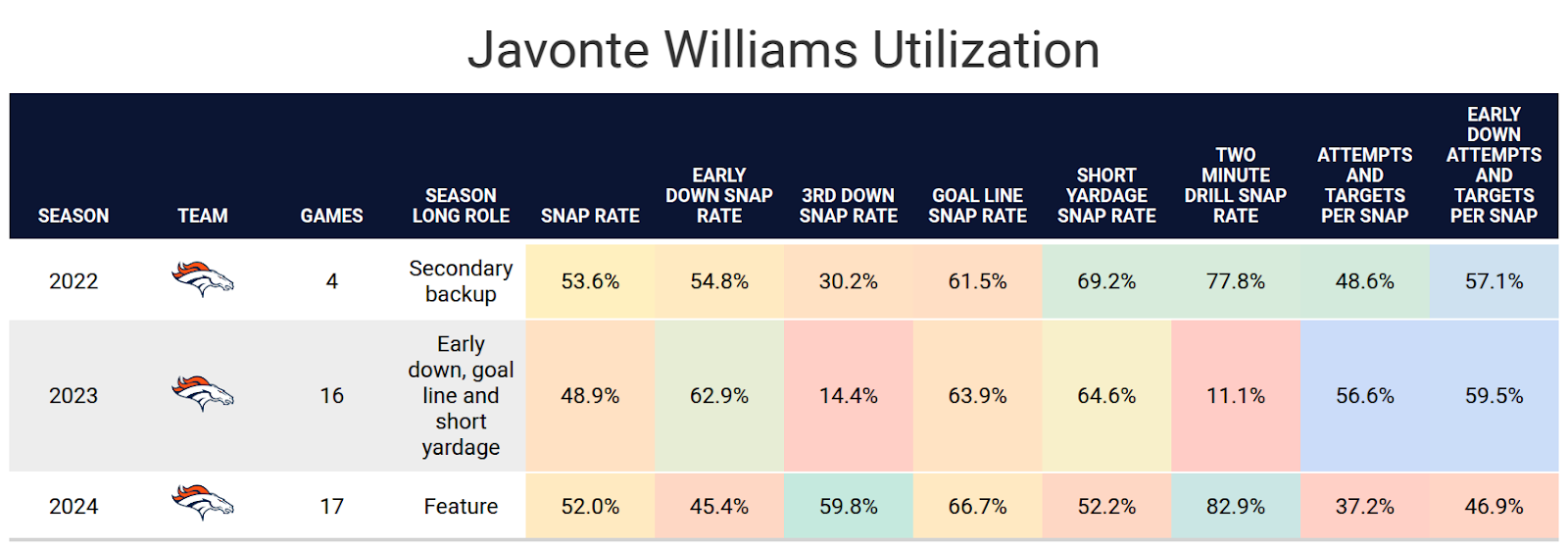
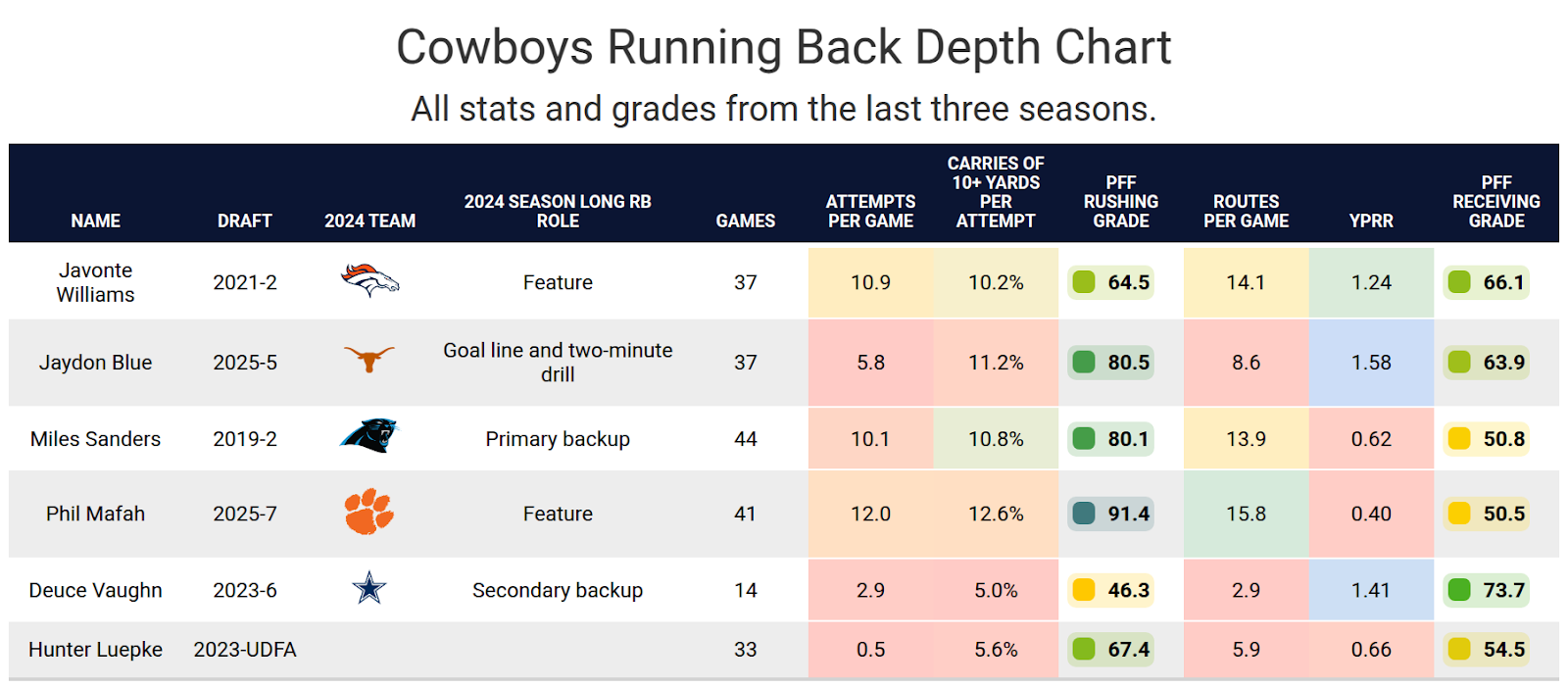
Impact of Teammates
The Dallas Cowboys' new head coach, Brian Schottenheimer, brings 14 years of experience as an NFL offensive coordinator. Historically, his lead running backs have averaged 13.4 PPR points per game — a mark that would have ranked RB21 last season. Only once has a Schottenheimer-led offense produced a running back who averaged over 16 PPR points per game: Thomas Jones in 2008. For context, 13 running backs reached that mark in 2024. Meanwhile, his primary backups have averaged just 7.4 points per game, which would have been RB47 last year.
Notably, in seven of Schottenheimer's last nine games as a playcaller, at least three different running backs logged 100 or more offensive snaps. That trend suggests a likely committee approach again in 2025, with all three backs — Javonte Williams, Miles Sanders, and Jaydon Blue — potentially seeing meaningful playing time. Even if one back emerges as the lead option, expectations should be tempered to low-end RB2 value at best.
The Cowboys' offensive line was slightly below average in run-blocking grade last season, a far cry from its dominant form in 2021. Of that elite 2021 unit, only Terence Steele remains on the roster. Steele and Tyler Smith are still the top run blockers on the line, though both experienced declines in performance in 2024. Dallas continued investing in the line by selecting Tyler Booker in the first round of the 2025 NFL Draft. While the long-term potential is promising, it may take time for the unit to gel and return to elite form this season.
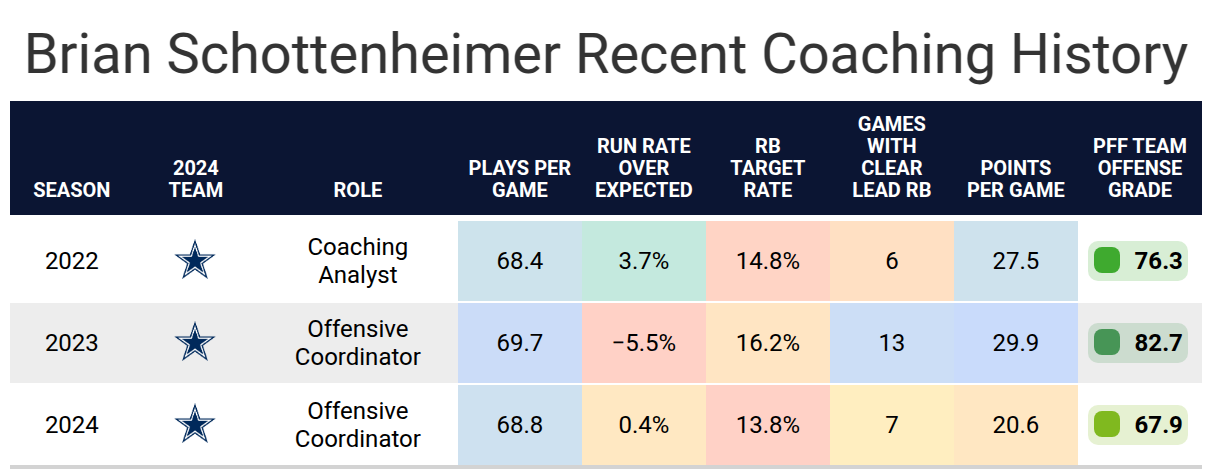
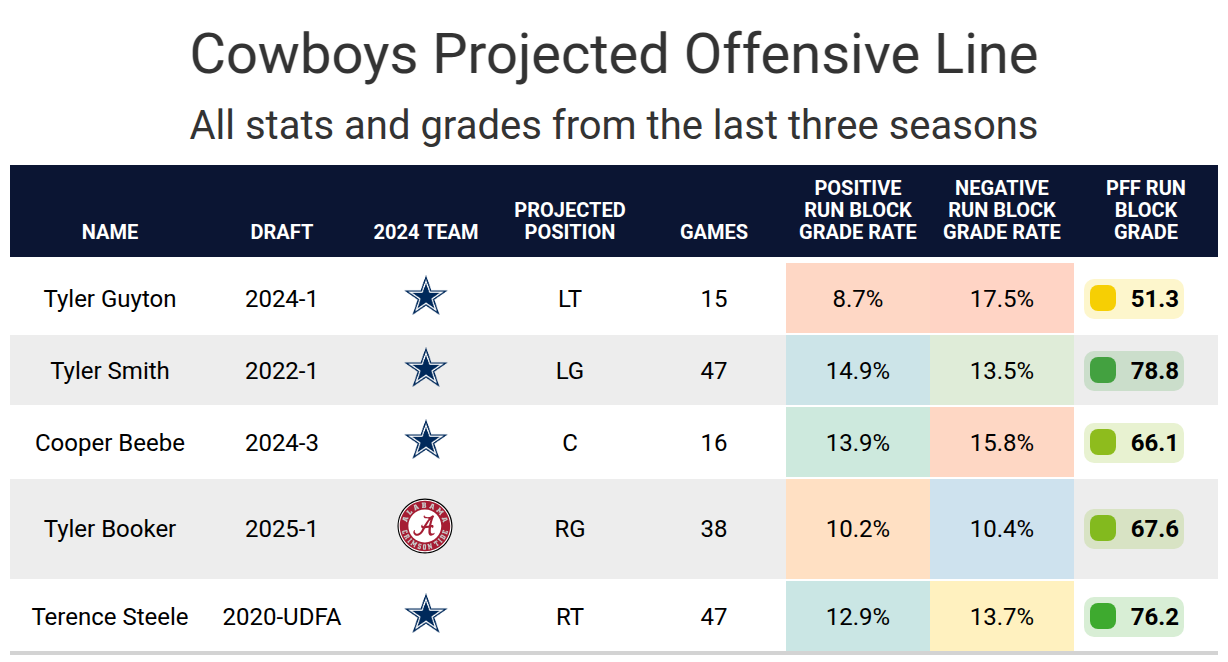
Bottom Line
Williams just needs to beat out Miles Sanders and Jaydon Blue to become a potential fantasy starter, but he will need to regain his form from before his ACL and LCL injury before anyone feels comfortable putting him in starting fantasy lineups.
Footnotes
- Statistics in tables and charts were chosen based on their ability to predict future fantasy performance on a per-game or per-opportunity basis or to describe the player relative to others at the same position.
- “Opportunities” are defined as passing dropbacks, rushing attempts and routes run as a receiver.
- Numbers are provided either by season or based on the past three years. For rookies, only college statistics are included. For non-rookies, only NFL statistics are considered, regardless of whether they played in college within the previous three years.
- As college competition is easier than NFL competition, most rookies are likely to see a decline from their historical numbers.
- Only FBS data is considered for college players and comparisons.
- Kneel-downs are removed from rushing data to provide cleaner quarterback rushing rate statistics.
- The table colors in this article range from blue (indicating good/high) to red (indicating bad/low).
- All percentiles and color codings compare the given player to others with a high sample of opportunities. Generally, the cutoff is one-third of the possible opportunities in the sample. If a player does not meet the threshold, they are still included in the comparison, though their results may appear better or worse than expected due to the smaller, less predictive sample size.
- Information on utilization classifications and their importance can be found here for running backs, wide receivers and tight ends.
[/am4show]



 © 2025 PFF - all rights reserved.
© 2025 PFF - all rights reserved.